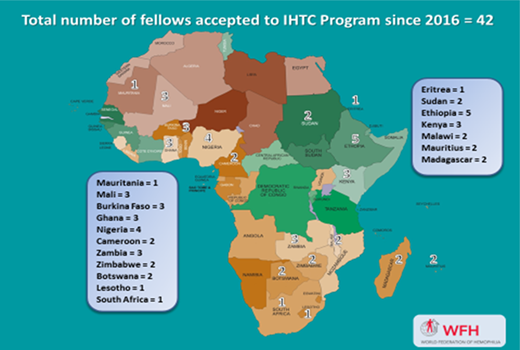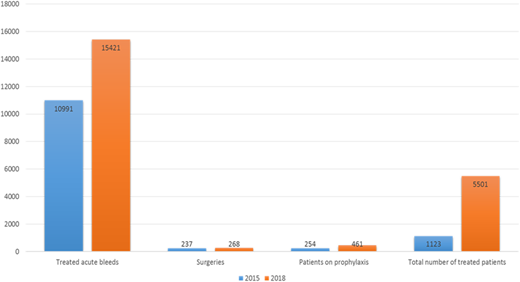Background
Hemophilia is a rare genetic disease that results from mutations in the genes that code for proteins necessary for normal blood clotting, factor VIII (hemophilia A) and factor IX (hemophilia B). Although there is evidence that the incidence of hemophilia is constant in different populations, there is a wide variation in the reported prevalence of hemophilia across countries. With 18% of the world’s population, Africa represents less than 3% of patients identified as having hemophilia, and only 2% of those use clotting factor concentrates (CFCs) for treatment. It is likely that these differences between countries are the result of differential capacities for prompt and accurate diagnosis and for the provision of care necessary for survival. Diagnosis and care for hemophilia are heavily dependent on the availability of trained health care professionals and CFCs.
The World Federation of Hemophilia (WFH), an international not-for-profit organization, has a mission to improve and sustain care for people with inherited bleeding disorders around the world. WFH works closely in partnership with hemophilia treatment centers (HTCs) in 29 African countries to share knowledge and build global awareness through information exchange, education, and training. WFH also provides ∼24 million units of CFCs per year to patients in sub-Saharan Africa through a humanitarian aid program.
Objectives of the partnership between WHF and HTCs
To build a large network of health care professionals (HCPs) in Africa who are well trained in hemophilia care.
To increase the number of people identified with hemophilia in sub-Saharan Africa.
To improve hemophilia care in this region.
Stakeholders
The WFH is an international, Canadian-based not-for-profit health organization that was established in Montreal, Canada, in 1963 with a membership of 140 countries, and it is officially recognized by the World Health Organization (WHO). The WFH has been dedicated to improving hemophilia care worldwide for the last 56 years. It has provided global leadership in training experts in the field to properly diagnose and manage patients, advocating for an adequate supply of safe treatment products, and educating and empowering people with bleeding disorders on how to improve their quality of life.
The WFH will:
○ Organize international educational and training workshops and support all financial and logistical issues.
○ Award fellowships to give HCP staff training in the diagnosis and management of hemophilia and other inherited bleeding disorders. The staff members travel to one of the designated International Hemophilia Training Centers (IHTCs) for 4 to 6 weeks of training in the clinical, assay, and medical aspects of hemophilia management.
○ Provide consistent and predictable access to humanitarian aid treatment to change the lack of access to CFCs
The WFH will establish IHTCs in sub-Saharan Africa (Dakar and Johannesburg) that are designated as treatment centers committed to assisting other countries by providing fellowship training in caring for patients with bleeding disorders in accordance with WFH priorities. IHTCs are responsible for:
○ Providing specialized training for WFH fellows in caring for people with bleeding disorders;
○ Arranging logistic support for WFH fellows, including accommodation, meals, and local transportation;
○ Completing evaluation reports on WFH fellowship trainings;
○ Updating WFH Headquarters on training results and feedback; and
○ Monitoring standardized IHTC course content.
Participants from all African countries in which a medical team has been recognized as providing different levels of care for hemophilia patients have an opportunity to be included in capacity building programs and to benefit on a step-by-step basis. Regional and national workshops are organized within countries for more in-depth training via WFH humanitarian aid (HA) and programs specific to each country, respectively.
Results of the WFH capacity building program
Creation of a large African network of HCPs who have been well trained in treating and caring for patients with hemophilia.
Workshops
○ Thirty workshops were organized from 2016 to 2018 (Figures 1-3).
○ These workshops were specific to the topics of medical support, nurses, laboratory diagnosis, physiotherapy, and social support.
○ There was a total of 600 participants during these 3 years from 29 African countries.
○ In addition, an African summit was organized in Senegal in 2017 and another in Johannesburg in 2019, with representatives from many African countries meeting to exchange best practices and gain further training.
Fellowships
○ In all, 42 HCPs from 18 countries were awarded fellowships to be trained in IHTCs from 2016 to 2018; follow-up assessment shows that all the fellows continue to be active in the field of hemophilia and bleeding disorders (Figure 4)
There was an increase in the number of people identified with hemophilia in sub-Saharan Africa after having the program for 3 years (2016-2018).
An increase of 25.9% was seen in the number of identified patients with hemophilia A and hemophilia B from 4397 to 5540 during the 3 years between 2016 and 2018. This increase was also observed for von Willebrand disease (increased from 722 to 759) and for other rare bleeding disorders (increased from 253 to 304). In total, the number of identified patients who had inherited bleeding disorders increased from 5372 to 6603 (ie, a 22.9% increase; Figure 5).
There has been considerable improvement in hemophilia care in sub-Saharan Africa between 2016 and 2018 (Figure 6).
The number of donated CFCs rose from 11 million international units (IUs) to a total of 80 million IUs between 2016 and 2018. With enhanced access to treatment and better training, the following improvements have been observed:
○ The number of patients treated with donated CFCs increased from 1123 to 5501.
○ The number of surgeries performed using these donations increased from 237 to 268.
○ The number of acute bleeds treated using HA donations moved from 10 991 to 17 421, and
○ The number of patients who received prophylaxis using HA donations increased from 254 to 461.
Increase in the number of patients from 2016 to 2018 in sub-Saharan Africa.
Evolution of hemophilia treatment in sub-Saharan Africa from 2016 to 2018.
Conclusion
An array of capacity building assistance initiatives has led to expansion of a large and multinational network of health care professionals with good knowledge of how to diagnose and treat hemophilia in patients who live in sub-Saharan Africa. It has allowed a good and efficient exchange between North-South and South-South HCPs, and as a result of this collaboration, there has been an increase in the diagnosis and quality of treatment for people with hemophilia and other bleeding disorders. Capacity building was crucial in improving the quality of life of people with inherited bleeding disorders in sub-Saharan Africa.
Authorship
Conflict-of-interest disclosure: The authors declare no competing financial interests.
Correspondence: Saliou Diop, Hematology Department, Cheikh Anta Diop University and Centre National de Transfusion Sanguine, BP 5002 Dakar Fann, Dakar, Senegal; e-mail: saliou.diop@ucad.edu.sn.






